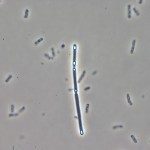Lien vers Pubmed [PMID] – 25432742
Meth. Enzymol. 2014;549:3-27
Deep-sequencing technologies applied to RNA have tremendous potential to identify novel transcripts with single-nucleotide resolution. By combining whole-transcript cDNA sequencing (RNA-seq) and genome-wide identification of transcription start sites (dRNA-seq), it is possible to characterize long 5′-untranslated regions potentially endowed with regulatory capacities and to detect premature termination of transcription. This can be used to identify new potential riboswitches. In this chapter, we provide a detailed protocol of the dRNA-seq method based on differential pretreatment of RNAs with tobacco acid pyrophosphatase to differentiate between 5′-ends of primary and processed RNAs. We also give a briefer protocol of the preparation of RNA-seq libraries and of how to go through data bioinformatics analysis and data visualization using genome browsers. This approach is powerful to identify novel riboswitches and to demonstrate the functionality of riboswitches predicted in silico.

